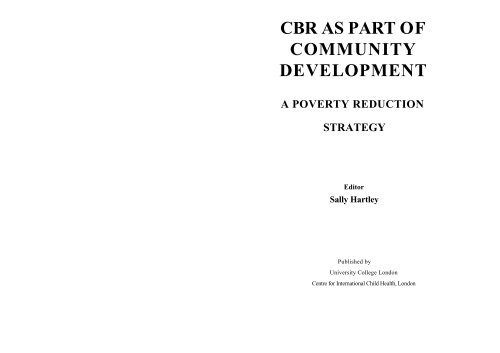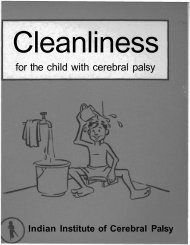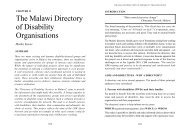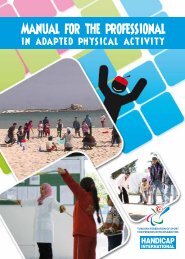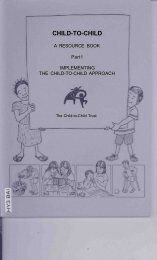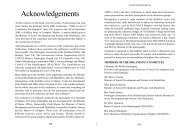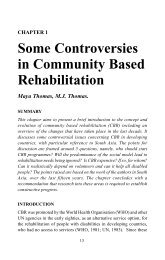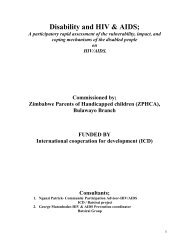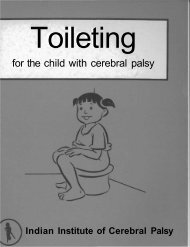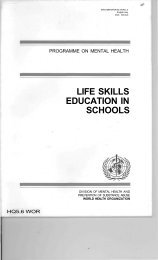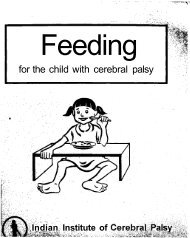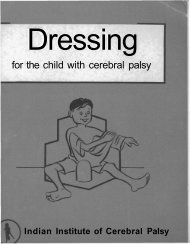CBR AS PART OF COMMUNITY DEVELOPMENT - Source
CBR AS PART OF COMMUNITY DEVELOPMENT - Source
CBR AS PART OF COMMUNITY DEVELOPMENT - Source
Create successful ePaper yourself
Turn your PDF publications into a flip-book with our unique Google optimized e-Paper software.
<strong>CBR</strong> <strong>AS</strong> <strong>PART</strong> <strong>OF</strong><br />
<strong>COMMUNITY</strong><br />
<strong>DEVELOPMENT</strong><br />
A POVERTY REDUCTION<br />
STRATEGY<br />
Editor<br />
Sally Hartley<br />
Published by<br />
University College London<br />
Centre for International Child Health, London
ISBN: 0-9532265-3-0<br />
978-0-9532265-3-5<br />
©University College London, Centre for<br />
International Child Health, 2006<br />
Contents<br />
First published 2006<br />
University College London, Institute of Child Health,<br />
Centre for International Child Health 30 Guilford<br />
Street, London WC IN IEH<br />
Cover Design<br />
Chris Serwaniko<br />
This book is available from<br />
TALC<br />
PO Box 49, St. Albans, Herts, AL1 5TX, U.K. Tel:<br />
+44 (0) 1727 853869, Fax: +44 (0) 1727 846852 E-<br />
mail: info@talcuk.org / e-talc@talcuk.org<br />
Printed at<br />
National Printing Press, 580, K.R. Garden, 8th Block<br />
Koramangala, Bangalore - 560 095, India.<br />
E-mail: nppbangalore@touchtelindia.net<br />
Production and distribution co-ordinated by<br />
Asia Pacific Disability Rehabilitation Journal Editorial team<br />
J-124,UshaApts, 16th Main, 4th Block Jayanagar,<br />
Bangalore-560 Oil, India. E-mail:<br />
m_thomas@redifmiaiLcom<br />
SPONSORED BY CP<br />
CHARITABLE TRUST, U.K.<br />
NORWEGIAN <strong>AS</strong>SOCIATION <strong>OF</strong>THE DISABLED (NAD)<br />
NORWAY<br />
Forewords<br />
Contributors<br />
Acronyms Used<br />
Editorial<br />
Sally Hartley<br />
Community-based Rehabilitation Africa Network (CAN)<br />
Shay a Asindua<br />
<strong>CBR</strong> as Part of Community Development and<br />
Poverty Reduction<br />
Peter Coleridge<br />
<strong>CBR</strong> as Part of Social, Cultural and Political<br />
Development<br />
Benon Christopher Ndaziboneye, Isaac Nyathi,<br />
Fredrick Mzoma<br />
<strong>CBR</strong> and Economic Empowerment of Persons with<br />
Disabilities<br />
Daniel Vershima Tsengu, Svein Brodtkorb, TorildAlmnes<br />
Community-based Rehabilitation as Part of Inclusive<br />
Education and Development<br />
AlickH.P. Chavuta, Edward Kimuli, Orpa Ogot<br />
<strong>CBR</strong> as Part of Community Health Development<br />
Alice Baingana Nganwa, Chapal Khasnabis<br />
HIV and AIDS, and Disability<br />
Lisa Davidson<br />
VII<br />
XV<br />
1<br />
11<br />
19<br />
40<br />
49<br />
64<br />
74<br />
91
International Classification of Functioning, Disability<br />
and Health (ICF), and <strong>CBR</strong><br />
Margie Schneider, Sally Hartley<br />
<strong>CBR</strong> Research as Part of Community Development<br />
Harry Finkenflugel, Servious Dube, Alister Munthali,<br />
Mitchell Loeb<br />
Information Sharing and Community-based<br />
Rehabilitation<br />
Stefan Lorenzkowski<br />
The Malawi Directory of Disability Organisations<br />
Marko Kerac<br />
Acknowledgements<br />
Appendix 1<br />
Group Discussion Questions<br />
Appendix 2<br />
List of Participants<br />
Appendix 3<br />
12 Key Messages<br />
96<br />
116<br />
149<br />
162<br />
168<br />
172<br />
175<br />
187<br />
FOREWORD<br />
FROM THE GOVERNMENT <strong>OF</strong> MALAWI<br />
Malawi was honoured and privileged to host the 2nd Africa Regional<br />
Conference on <strong>CBR</strong> on behalf of the <strong>CBR</strong> Africa Network that was<br />
held at Kalikuti Hotel in Lilongwe from the 31st August to the 3rd<br />
September 2004. It was a delight to host so many participants from<br />
across Africa and Europe whom I trust enjoyed the unique warmth and<br />
hospitality of Malawi, the Warm Heart of Africa. I would, therefore,<br />
like to thank the organisers for choosing Malawi as the venue for this<br />
international conference. To us, this was a reflection of the trust and<br />
goodwill that the country has earned in the international community.<br />
It was gratifying to note the response and attendance of the Conference<br />
which brought together so many players working with or for people with<br />
disabilities and <strong>CBR</strong> from a number of countries in Africa and beyond.<br />
Delegates came together in the spirit of cooperation and partnership to<br />
share ideas and experiences on how to promote Community-Based<br />
Rehabilitation; and to examine the evidence that <strong>CBR</strong> is an integral part<br />
of community development in Africa.<br />
There is no doubt in my mind that the conference participants believe<br />
and support the vital role of people with disabilities in community<br />
development. In Malawi, as indeed in any African country, we cannot<br />
expect to reduce poverty or achieve our socio-economic development<br />
goals without the inclusion or participation of persons with disabilities.<br />
Our major challenge, therefore, as a disability sector is to ensure that all<br />
other sectors share a similar view and are so aware of disability issues<br />
that the inclusion of persons with disabilities in development forums,<br />
policies and programmes becomes second nature and lobbying<br />
government, international partners and policy makers becomes a thing<br />
of the past.
Although most readers will find the book irresistible, let me urge you all<br />
to use this book primarily as an encouragement and inspiration to<br />
ourselves working in the disability sector and learn from the shared<br />
experiences so that we can continue to empower the lives of persons<br />
with disabilities in our countries. Secondly, this book should be used as<br />
an advocacy tool to change the mindset of our politicians, governments<br />
and other policy makers to mainstream disability in all areas of community<br />
development. It is my fervent hope that this book will open the door for<br />
local and international forums to actively involve people with disabilities<br />
when they meet to discuss important social and economic issues<br />
concerning our nations.<br />
While all the development issues raised in this book are equally important,<br />
I would like to stress the importance of research in <strong>CBR</strong> as part of<br />
community development. "Inclusive" research offers us a gateway into<br />
development forums and onto development agendas. With valid and<br />
reliable evidence, disability issues cannot be ignored and can only lead to<br />
positive development for people with disabilities and our nations.<br />
Finally, let us all make use of the <strong>CBR</strong> Africa Network website and the<br />
directory at the back of this book to continue to share our research,<br />
experiences and knowledge so that disability is mainstreamed in all sectors<br />
and in every African nation.<br />
Elias U. Ngongondo<br />
Secretary for Social Development and Persons with Disabilities<br />
Government of Malawi<br />
FOREWORD<br />
FROM THE NORWEGIAN <strong>AS</strong>SOCIATION <strong>OF</strong><br />
DISABLED (NAD)<br />
The perception of community based rehabilitation (<strong>CBR</strong>) has changed<br />
substantially since its inception more than two decades ago. The initial<br />
small projects were developed in isolation with a kind of personal view<br />
of what <strong>CBR</strong> was supposed to be. Further, in the past the term<br />
rehabilitation reflected a medical and diagnostic approach which ignored<br />
the imperfections and deficiencies of the surrounding society and<br />
environment.<br />
Globalisation in terms of increased opportunities of sharing knowledge<br />
and experiences, as well as the strong involvement of disabled people<br />
has changed this, and today <strong>CBR</strong> increasingly tends to bear the same<br />
meaning all over the world. The current terminology recognises the<br />
necessity of addressing both the individual needs such as rehabilitation<br />
and technical aids, as well as the shortcomings of the society and its<br />
various obstacles and barriers for participation.<br />
The global recognition of a more holistic approach to rehabilitation can<br />
largely be attributed to initiatives which bring key stakeholders in the<br />
field of <strong>CBR</strong> to seminars and workshops on a regional and global basis.<br />
For example the two CAN conferences held in Uganda 2001 and in<br />
Malawi in 2004, with participants from more than 20 different countries,<br />
have brought about valuable opportunities to learn from one another and<br />
expanded our ability to respond to the rights and the needs of persons<br />
with disabilities in their community.<br />
In the late eighties NAD made a strategic shift in its development<br />
assistance to disabled persons, from institutional to community based<br />
rehabilitation maintaining a strong representation from the local<br />
governments. At the same time NADs support to disabled persons<br />
organisations (DPO) has had equally high priority. This twin track<br />
iii
approach; strengthening the duty bearers on the one hand and the rights<br />
holders on the other; aims to strengthen their respective roles,<br />
responsibilities and performance in the society, as well as the<br />
communication and interaction between the two. It is therefore not a<br />
coincidence that NAD has supported the two CAN conferences in<br />
Uganda and Malawi, since our organisation also supports their two<br />
governments in developing national community based rehabilitation<br />
programmes.<br />
A prerequisite for NAD's support to these conferences has been that all<br />
the presentations, deliberations and discussions during the workshops<br />
should be captured and translated into a book to be shared with a wider<br />
audience. We do therefore sincerely hope that this book will be widely<br />
distributed and read by senior government officials, NGO managers and<br />
community development workers. Most importantly we hope that it will<br />
trigger the interest of disabled persons' organisations and encourage<br />
them to take an active role in the planning and implementation of<br />
community based rehabilitation programmes throughout the African<br />
continent.<br />
Lars 0degard<br />
Secretary General The Norwegian Association of<br />
Disabled - NAD<br />
FOREWORD<br />
FROM ICH, U.K.<br />
It is a great pleasure to be invited to provide the foreword for this book<br />
which provides clear statements as to how <strong>CBR</strong> must be seen as part of<br />
other mainstream services and activities and can no longer be viewed as<br />
an as add-on service only if there is a budget available. The book<br />
demonstrates how far <strong>CBR</strong> AFRICA NETWORK (CAN) has progressed<br />
over the past 4 years, Shaya Asindua in the first chapter outlines the growth<br />
of CAN and is proud to acknowledge its role in promoting the largely<br />
African authorship of the majority of the chapters in this book. It shows<br />
that practitioners from throughout the African continent are now able to<br />
share their experiences with readers throughout the world.<br />
The book extends some of the papers given at the conference and<br />
addresses not only of how <strong>CBR</strong> should be, but also gives examples of<br />
how <strong>CBR</strong> can be integrated into different services including health,<br />
economic, education, social and cultural sectors. Peter Coleridge in the<br />
second chapter addresses the issue of how <strong>CBR</strong> can address the all<br />
important issue of poverty reduction for persons with disability and their<br />
families. In this chapter he gives a thoughtful overview of factors, which<br />
have inhibited the economic progress of persons with disability and<br />
challenges the World Bank's view in 1999 (before the appointment of<br />
Judy Heuman) that persons with disability are economically inactive.<br />
There then follow four interesting chapters illustrating how <strong>CBR</strong> can be<br />
integrated into first social cultural and political development, secondly<br />
into the economic development of a community, thirdly into community<br />
health development and finally how <strong>CBR</strong> should be perceived as part of<br />
the inclusive education movement.<br />
The under recognised issue of the impact of the HIV/AIDS pandemic<br />
upon persons with disability and the way in which the (relatively) new<br />
ICF classification system from WHO can be used to assist <strong>CBR</strong> activities
are then presented in in the next two chapters. The great strength of the<br />
ICF chapter is that it gives several illustrative examples which will be<br />
useful to practitioners.<br />
It is unfortunate that the authors of some chapters fail to relate the ideas<br />
they promulgate to the published literature. This is especially important<br />
where chapter authors are trying to change attitudes of readers who are<br />
not closely involved with <strong>CBR</strong> such as the issue of <strong>CBR</strong> and HIV/<br />
AIDS. This is a book primarily about <strong>CBR</strong> in Africa but should be useful<br />
to readers working in <strong>CBR</strong> and community development from South<br />
Asia, South East Asia, Central Asia and elsewhere, all of whom have<br />
slightly different interpretations of <strong>CBR</strong> but these African interpretations<br />
may also fit into community development regimes in their settings<br />
The three final chapters stress the need for exchange of information.<br />
One gives an excellent summary of sources of information about <strong>CBR</strong><br />
that must be of value to any programme planner. Another gives a directory<br />
of disability services in Malawi. The chapter on <strong>CBR</strong> research as part<br />
of community development reviews 25 years of research in <strong>CBR</strong><br />
specifically seeking the evidence base for this work It notes the need for<br />
more writing and recording of good practice and says "without such<br />
work <strong>CBR</strong> development will be slow and many programmes will<br />
continue to function in ways which others have already discarded".<br />
The participants of the Lilongwe conference, the chapter authors of this<br />
book and the editor Sally Hartley have all produced a book, which<br />
addresses the challenge raised in the quote above.<br />
Sheila Wirz<br />
Professor of Disability and Development<br />
Institute of Child Health<br />
University College London<br />
Torild Almnes<br />
Contributors<br />
Torild has put in more than 20 years in Social Services in Oslo, Norway,<br />
most of the time as a director, and has more than 7 years of experience<br />
in African and Asian countries. She has been appointed to numerous<br />
governmental and private committees and boards. She has lectured at<br />
universities, national and international conferences and workshops. Her<br />
leadership abilities, motivation and inspirational skills are well known.<br />
She is now in Malawi as Senior Programme Adviser to the Government<br />
on disability issues, with special emphasis on developing a new <strong>CBR</strong><br />
model for the country. She also assists FEDOMA, the umbrella<br />
organisation for DPOs and its 7 member organisations. She is on contract<br />
with the Norwegian Association for the Disabled.<br />
Shaya Asindua<br />
Shay a has over twenty years of experience in working in disability and<br />
development, at both community and policy levels. She has been the key<br />
in developing and adapting the <strong>CBR</strong> concept as a meaningful tool for<br />
development work and empowering disabled persons in Africa. Shaya<br />
works for Leonard Cheshire International as the East and North African<br />
Regional Programme Manager. She is presently the Chairperson of the<br />
<strong>CBR</strong> Africa Network.<br />
Svein Brodtkorb<br />
S vein is a Senior Adviser to the Norwegian Association of Disabled. He<br />
spent 4 years (1991-1995) in Uganda, as advisor to the national <strong>CBR</strong><br />
programme during the early stages of the programme. Since 1995, he<br />
has been based in the NAD Head Office in Norway, with particular
esponsibility for following up <strong>CBR</strong> programmes and organisational<br />
development among DPOs in Uganda, Malawi and Lesotho.<br />
Alick H.P. Chavuta<br />
Alick Chavuta is currently working at Montfort College of Special Needs<br />
Education, Malawi, as a senior lecturer in special needs education. He is<br />
the head of the Learning Difficulties Programme and has vast experience<br />
in special needs education. His research interests include inclusive<br />
education, education of children with learning difficulties and coping<br />
strategies for parents of children with disabilities. Alick has a Master's<br />
degree in Community Disability Studies in Developing Countries from<br />
the University College, London.<br />
Peter Coleridge<br />
Peter has worked in disability and development, for more than 25 years<br />
in the Middle East, Afghanistan and East Africa. He is the author of<br />
"Disability, Liberation, and Development" (Oxfam 1994) and numerous<br />
papers on disability and development. He is currently engaged in an ILO<br />
research project, on skills development and access to work for disabled<br />
people in developing countries.<br />
Lisa Davidson<br />
Lisa originally went to Namibia as a volunteer to work on a TB and<br />
malaria programme in 1996. Soon after arrival, it became apparent that<br />
any work regarding TB and malaria needed also to address HIV and<br />
AIDS, and very quickly this became the main focal point of her work.<br />
Three years ago, she started working for VSO, supporting their HIV<br />
and AIDS programmes. Part of this job included supporting volunteers<br />
working in other sectors such as education, secure livelihoods and<br />
disability to mainstream HIV and AIDS. In 2003 she was involved in a<br />
national conference on Disability, HIV and AIDS and the programme<br />
she is presently working on, grew out of it.<br />
Servious Dube<br />
Servious has been working for over twenty years in health, community<br />
development and disability within government and NGOs, at implementation<br />
and senior management levels. This has been in both his home country,<br />
Zimbabwe, and as an expatriate development worker in other African<br />
countries. He is now working for Leonard Cheshire International (UK) as<br />
a Senior Programme Manager for Africa, based in London. He has also<br />
worked for Save the Children UK, job sharing on the disability adviser's<br />
position. He was involved in research work from 1999 to 2002, at the<br />
Institute of Child Health, University College London as an Associate Fellow.<br />
Together with Professor Sheila Wirz, he investigated the possibility of<br />
designing a low cost hearing screen for identifying permanent hearing loss<br />
in young children in low income countries.<br />
Harry Finkenfliigel<br />
Harry was involved in the <strong>CBR</strong> pilot projects in Zimbabwe (1988-1991),<br />
and has since then been committed to the development of the <strong>CBR</strong><br />
concept. He has published several articles and edited two books on <strong>CBR</strong><br />
including, "Empowered to differ, stakeholders' influences in <strong>CBR</strong>"<br />
(2004). As a researcher at the Institute of Health Policy and Management<br />
of the Erasmus University of Rotterdam, the Netherlands, he has<br />
committed himself to research into conceptual models, competencies of<br />
stakeholders and effectiveness of community care programmes in the<br />
Netherlands and Sub-Saharan Africa.<br />
Sally Hartley<br />
Sally has worked with and for disabled people in many African countries<br />
over a period of 30 years. She was a Senior Research Fellow at the<br />
Institute of Child Health, London University till 2005. Her research<br />
has focused on community approaches to improving the quality of life<br />
of disabled people in low-income countries. Sally is the Executive
Director of CAN and from 2006, she has taken up a position as<br />
Professor of Communication and Health at the University of East<br />
AngHa, UK.<br />
Marko Kerac<br />
Marko is a medical doctor who completed basic specialist training in<br />
paediatrics in the UK. His interest in disability was inspired by a childhood<br />
friend as well as a 'Community Child Health' job working in inner city<br />
London. From 2003-4, he spent a year at the Malawi College of Medicine,<br />
Blantyre, working as a paediatric registrar and lecturer. Having been<br />
captivated by "The Warm Heart of Africa", he is going back in January<br />
2006, this time for 2-4 years, doing a PhD on 'CTC '(Community-based<br />
Therapeutic Care) for severely malnourished children. Links and<br />
friendships, made whilst compiling the directory, are a maj or factor behind<br />
the plans to return.<br />
Chapal Khasnabis<br />
Chapal Khasnabis graduated in Prosthetics and Orthotics Engineering<br />
from the All India Institute of Physical Medicine and Rehabilitation,<br />
Mumbai, India in 1979. He then joined the National Institute for the<br />
Orthopaedically Handicapped, under the Ministry of Social Welfare.<br />
After 15 years in government, he started a highly successful NGO<br />
named Mobility India. Mr Khasnabis is currently a Technical Officer<br />
in the Disability and Rehabilitation team in the VIP department of WHO,<br />
Geneva.. His responsibilities include the promotion of community based<br />
rehabilitation and assistive devices. He uses his 25 years of work<br />
experience in government and NGOs, to ensure that rehabilitation<br />
services reach the majority of people who need them, particularly the<br />
poor and women.<br />
Edward Kisolo Kimuli<br />
Edward Kimuli is presently the Deputy Vice Chancellor of the new<br />
University of Kyambogo in Kampala, Uganda. He was previously the<br />
Director of The Uganda National Institute of Special Education (UNISE)<br />
and the Chairperson of the committee, which planned and hosted the<br />
first <strong>CBR</strong> Africa Network conference, '<strong>CBR</strong> as a Participatory Strategy<br />
in Africa, in 2001.'<br />
Mitchell Loeb<br />
Mitchell works for SINTEF Health Research. He has a B.Sc. (Biology)<br />
and M.Sc. (Epidemiology) with 25 years of experience in<br />
epidemiological research methodology and the analysis of statistical<br />
research data. Relevant work experience includes research in<br />
developing countries/emerging democracies, including environmental<br />
epidemiology in Kenya, Poland and Romania, studies of living conditions<br />
among people with disabilities in Namibia, Zimbabwe, Malawi, Zambia<br />
and South Africa, and quantitative data collection and analysis on<br />
disability in Indonesia.<br />
Stefan Lorenzkowski<br />
Stefan is working in Central Asia where he supports the development of<br />
a regional programme with a focus on inclusive development, for<br />
Handicap International. Earlier, he worked for the "<strong>Source</strong>" Information<br />
Resource Centre at the Institute of Child Health, London, as the Disability<br />
Information Officer. He was in charge of making disability relevant<br />
information, more readily available.<br />
xi
Alister Munthali<br />
Alister has an M.A. and Ph.D. (Medical Anthropology). His research<br />
thesis was entitiled "Change and Continuity in Perceptions about Childhood<br />
Illnesses in Northern Malawi." His current position is Research Fellow<br />
at the Centre for Social Research, Zomba, Malawi. Since January 1996.<br />
Dr. Munthali has conducted a number of studies mainly in the field of<br />
medical anthropology, with special interest in children - including<br />
vaccinations, and health and illness in African societies.<br />
Fredrick Blesius Venus Mzoma<br />
Fredrick is a polio survivour, born in 1960. He went to mainstream schools<br />
for primary, secondary and university education and graduated from the<br />
University of Malawi in 1983, with a Bachelor of Arts degree. He worked<br />
for the government and retired at Permanent Secretary level. He now<br />
works on contract for the government, assisting with the setting up of a<br />
new directorate to oversee public procurement. Fred has been in the<br />
disability movement since the early eighties and was one of the founding<br />
members of Disabled Peoples Association in Malawi. As its Executive<br />
Chairman, in 1998, he successfully lobbied for the rights of persons with<br />
disability which led to the president creating a Ministry to specifically<br />
take charge of persons with disabilities. He was appointed its first<br />
Permanent Secretary.<br />
Benon Christopher Ndaziboneye<br />
Benon has been a very active member of the National Union of Disabled<br />
Persons in Uganda (NUDIPU) and in this capacity, he has made<br />
remarkable contributions in the area of co-ordinating organisations and<br />
programmes for disabled persons in Uganda. He has worked for Action<br />
on Disability and Development (ADD) and for the <strong>CBR</strong> Africa Network<br />
(CAN) also in Uganda.<br />
Alice Baingana Nganwa<br />
Dr. Nganwa is a medical doctor working in Uganda as the Director of<br />
Injury Control Centre, Uganda. She previously worked for the Ministry<br />
of Health, Headquarters in Uganda, where she established the Disability<br />
Prevention and Rehabilitation Section. While in the Ministry she guided<br />
the development of the health disability policy, policy for prevention of<br />
blindness, deafness and injury. She is on the Uganda National <strong>CBR</strong><br />
committee and works with WHO on new <strong>CBR</strong> guidelines. Dr. Nganwa<br />
has been involved in research, training and programme development in<br />
disability in Uganda, Lesotho and Southern Sudan.<br />
Orpa Ogot<br />
Orpa is the Inclusive Education Liaison Officer for Leonard Cheshire<br />
International, East and North Africa Region. Her particular responsibility<br />
lies with the Oriang Cheshire Inclusive Education Project, Kenya. She<br />
has a B.Ed (Special Education). She previously worked as Inspector of<br />
schools in charge of special education programmes in Nyanza Province,<br />
as a teacher of special education for visually impaired children in regular<br />
school. Her current career focus is to influence government policy on<br />
inclusive education. In the future she hopes to do this through research,<br />
on the inclusion of children with disabilities into educations in the early<br />
years.<br />
Margie Schneider<br />
Margie is a Chief Research Manager in the Child, Youth and Family<br />
Development Research Programme, at the Health Services Research<br />
Council (HSRC) South Africa. She initially trained as a Speech Therapist<br />
andAudiologist, but since 1995, has been involved in research on disability<br />
broadly. Her areas of research interest include disability assessment<br />
and measurement, disability in relation to exclusion and poverty, public<br />
health and disability, and community based rehabilitation (<strong>CBR</strong>).<br />
Research projects include, the first national baseline survey on disability<br />
xii<br />
xiii
in South Africa, social security and disability. While working at WHO,<br />
Margie worked on the revision of the International Classification of<br />
Functioning, Disability and Health (ICF). Her publications have been<br />
mainly in the area of the disability and more specifically the role of the<br />
environment in disability.<br />
Daniel Vershima Tsengu<br />
Daniel works for Christoffel Blindenmission International (CBMI) as<br />
the National Assistant Coordinator. He has an MSc in Community<br />
Disability Studies, UCL, London University. As a disabled person himself<br />
he is particularly interested in the contribution that disabled people can<br />
make to their own destiny and in the economic aspects of community<br />
interventions.<br />
ABEK<br />
ADD<br />
APDK<br />
BOSEP<br />
CAN<br />
<strong>CBR</strong><br />
CDA<br />
CICH<br />
COMBRA<br />
CSO<br />
DPI<br />
DPO<br />
EARS<br />
EFA<br />
FEDOMA<br />
HSRC<br />
ICT<br />
IDDC<br />
IE<br />
IGA<br />
IGNOU<br />
DJO<br />
IMF<br />
INGOS<br />
LQ<br />
LNGOS<br />
MACOHA<br />
MDG<br />
MIEP<br />
Acronyms Used<br />
Alternative Basic Education for Karamoja, Uganda<br />
Action on Disability and Development<br />
Association for Physically Disabled, Kenya<br />
Build Own Small Enterprise Project, Bangladesh<br />
<strong>CBR</strong> Africa Network<br />
Community based Rehabilitation<br />
Community development assistant<br />
Centre for International Child Health, UK<br />
The Community Based Rehabilitation Alliance, Uganda<br />
Civil Society Organisations<br />
Disabled People's International<br />
Disabled People's Organisations<br />
Educational Assessment and Resource Services, Uganda<br />
Education For All<br />
The Federation of Disability Organisations in Malawi<br />
Health Services Research Council<br />
Information and Communication Technologies<br />
International Disability and Development Consortium<br />
Inclusive Education<br />
Income Generation Activities<br />
Indira Gandhi National Open University, India<br />
International Labour Organisation<br />
International Monetary Fund<br />
International Non-Governmental Organisations<br />
Leonard Cheshire International<br />
Local Non-Governmental Organisations<br />
Malawi Council of the Handicapped<br />
Millenium Development Goals<br />
Malawi Integrated Education Programme
Editorial<br />
Sally Hartley<br />
MLRR<br />
MPBOU<br />
NAD<br />
NFPDN<br />
NGO<br />
NUDIPU<br />
NUWODU<br />
PAP<br />
PHC<br />
PRSP<br />
PWD<br />
RAISA<br />
PJ<br />
SAFOD<br />
SARPV<br />
SCL<br />
SDC<br />
TALC<br />
TPA<br />
UNDP<br />
Ministry of Lands, Rehabilitation and Resettlement, Namibia<br />
Madhya Pradesh Bhoj Open University, India<br />
Norwegian Association of the Disabled<br />
National Federation of People with Disabilities in Namibia<br />
Non-Government Organisation<br />
National Union of Disabled Persons of Uganda<br />
National Union of Women with Disabilities of Uganda<br />
Poverty Alleviation Programmes<br />
Primary Health Care<br />
Poverty Reduction Strategy Paper<br />
People with Disabilities<br />
Regional AIDS Initiative in Southern Africa<br />
Rehabilitation International<br />
Southern Africa Federation of Disabled People<br />
Social Assistance and Rehabilitation for the Physically<br />
Vulnerable, Bangladesh<br />
Spinal Cord Lesion<br />
School Disability Committee, Kenya<br />
Teaching Aids at Low Cost<br />
Three Pillars Approach<br />
United Nations Development Programme<br />
UNESCO United Nations Educational, Scientific and Cultural<br />
Organisation<br />
UN1SE<br />
USDC<br />
WB<br />
WHO<br />
VSO<br />
WF<br />
Uganda National Institute of Special Education<br />
Uganda Society for Disabled Childern<br />
World Bank<br />
World Health Organisation<br />
Voluntary Services Overseas<br />
Vesicular - Vaginal Fistula<br />
INTRODUCTION<br />
This book has developed from presentations and discussions that took<br />
place in Malawi at a conference entitled, "<strong>CBR</strong> as part of Community<br />
Development". Some of the chapters remain an exact replication of the<br />
presentations that took place, whilst others have been strengthened by<br />
additional information from discussions or relevant literature. In addition<br />
some chapters have been added that were not presented at the conference<br />
at all. As such this publication is a reflection and development from the<br />
original conference, one that is much richer and has much more to offer,<br />
than a straightforward conference proceedings document.<br />
The choice of "<strong>CBR</strong> as part of Community Development" originates<br />
from the observation that the WHO/ILO/UNESCO (1994) definition of<br />
<strong>CBR</strong> states that "<strong>CBR</strong> is part of Community Development". The book<br />
examines how this key concept is played out in practice and what<br />
challenges and opportunities it presents to the stakeholders of <strong>CBR</strong><br />
programmes in Africa. Stakeholders here include disabled people<br />
themselves, planners, trainers, implementers and researchers of <strong>CBR</strong>.<br />
In 2004, at about the same time as the Malawi conference, WHO/ILO/<br />
UNESCO amended and re-ratified this Joint Position Paper (WHO/<br />
ILOAJNESCO, 2004). The amendments were relatively minor and <strong>CBR</strong><br />
remained defined as "a strategy within general community<br />
development". One key change however, related to the recognition of<br />
poverty as both a major determinant and an outcome of disability. This<br />
resulted in the inclusion of "poverty reduction" as a key element of the<br />
recommended <strong>CBR</strong> strategy. The decision by the UN agencies to include<br />
poverty in the definition of <strong>CBR</strong> is a major step in highlighting the<br />
importance of addressing poverty as part of <strong>CBR</strong> and provides another
<strong>CBR</strong> <strong>AS</strong> <strong>PART</strong> <strong>OF</strong> <strong>COMMUNITY</strong> <strong>DEVELOPMENT</strong><br />
EDITORIAL<br />
strong link with community development. The chapters in this book provide<br />
plenty of evidence to support the UN decision, and this is particularly<br />
well reviewed by Peter Coleridge in Chapter 2. The arguments presented<br />
underpin one of the main key messages of the conference, that <strong>CBR</strong><br />
must address poverty because it is the major need of people with<br />
disabilities.<br />
At the last <strong>CBR</strong> conference in Uganda, key tasks and players were<br />
identified for future activities, meetings were held and a new<br />
organisation was born. This organisation was named the "<strong>CBR</strong><br />
AFRICA NETWORK" (CAN) and part of its portfolio was the<br />
organisation of the conference in Malawi and the publication of this<br />
book. Chapter 1 by Shaya Asindua, the Chairperson of CAN, outlines<br />
the activities that have taken place in relation to the tasks that were<br />
identified. The Malawi meeting ratified this initiative in one of its key<br />
messages and agreed that "Sharing information is crucial to the<br />
development of <strong>CBR</strong>." This is perhaps the key message of CAN<br />
itself. Many people are doing good work but others never hear about it<br />
and the wheel is re-invented every-time. An excellent example of what<br />
can be done by individual countries as a first step towards tacking this<br />
can be found in Chapter 10 which describes an initiative in Malawi for<br />
collecting and sharing information about <strong>CBR</strong> related activities.<br />
Recognising the need for information sharing at all levels of operation<br />
is also crucial. Different mechanisms for sharing information may be<br />
required to achieve this. Books and journal articles may be a good<br />
medium for academics, but radio and drama may be the best way for<br />
rural community dissemination.<br />
CAN is working to address all these approaches and has made impressive<br />
progress. Its outputs clearly demonstrate determination to harness the<br />
strength of participatory approaches in Africa. These approaches are<br />
very much in line with the "African worldview" of a holistic and integrated<br />
way of looking at the family and the universe. They challenge the "Eurocentric<br />
worldview," which follows a more scientific paradigm and often<br />
looks at the whole in the separateness of the parts. This holistic approach<br />
has enabled CAN and its stakeholders to begin to develop structures<br />
that nurture information sharing between all the people involved in<br />
addressing the problems faced by disabled people.<br />
One of the main outputs from the Uganda conference was the<br />
identification of 10 key ingredients for <strong>CBR</strong> in Africa. These can be<br />
found in the book "<strong>CBR</strong> as a Participatory Strategy in Africa" or on the<br />
CAN web page www.afri-can.org Reflection on these ingredients over<br />
the intervening years and comparison with the Joint Position Paper on<br />
<strong>CBR</strong> (1994) and (2004), show many more similarities than differences.<br />
It has been obvious from the discussions and meetings of CAN that<br />
there is a great need to express the underlying concepts of <strong>CBR</strong> in an<br />
African way, one that resonates with disabled people and service<br />
providers on the continent. Interestingly the major difference between<br />
the key ingredients for Africa and the Joint Position Paper is the omission<br />
of "rehabilitation" as a key dimension in the African <strong>CBR</strong> ingredients.<br />
Two of the contributing reasons for this are firstly that the needs of<br />
disabled people in Africa relate strongly to the change required from the<br />
physical, political and social environment. Secondly the interpretation of<br />
'rehabilitation' is a narrow one.<br />
The traditional interpretation of the term "rehabilitation" focuses on<br />
changing the individual with the disability to "fit in" or to "normalize" his/<br />
her functioning. This reflects a medical/individual model approach, which<br />
as a single strategy has been found to be most unsatisfactory, not only to<br />
disabled people themselves, but also to many service providers. On the<br />
other hand, the social model demands that the change be made by society<br />
and the environment. As a direct alternative or substitute to the medical<br />
model it may still have some weaknesses. As Cole (1996) says "The<br />
'medical' and 'social' models are both partial understandings of<br />
the experience of disability. In both cases persons are seen as<br />
passive' victims of biology or society. " p. 14.<br />
In a comprehensive holistic approach the possibility that rehabilitation<br />
might offer a more positive contribution is sometimes overlooked..
<strong>CBR</strong> <strong>AS</strong> <strong>PART</strong> <strong>OF</strong> <strong>COMMUNITY</strong> <strong>DEVELOPMENT</strong><br />
EDITORIAL<br />
Maximising an individual's potential to perform activities related to dailyliving,<br />
participation and inclusion, may be potentially important mechanisms<br />
within <strong>CBR</strong> for achieving the goal of an improved quality of life. Chapter<br />
4 highlights this point in relation to the realities of economic empowerment<br />
and the need for disabled people to take responsibility for their own<br />
development and integration into society. Man can only liberate himself,<br />
he cannot be liberated by others. Maximising full potential through a<br />
rehabilitation process could be seen as part of this process. This<br />
observation and argument led to another key message of the conference,<br />
that "<strong>CBR</strong> should promote rights but also it should promote<br />
responsibilities."<br />
The African groups are not alone in their difficulties with including<br />
'rehabilitation' as a useful 'ingredient'. The 'R' of <strong>CBR</strong> has been the<br />
source of many discussions and debates summarised by Miles (1996).<br />
However representatives from the world <strong>CBR</strong> community in Helskinki<br />
(WHO 2003) agreed that, to change the name of <strong>CBR</strong> at this stage (two<br />
decades after its inception) would not be productive. A more constructive<br />
way forward is the realisation that the rehabilitation process can apply<br />
to the community as well as the individual and that <strong>CBR</strong> has an important<br />
role to play in "rehabilitating the community". Social integration, inclusion<br />
and awareness raising are, in reality, strategies for "rehabilitating the<br />
community". This perception does much to vindicate the use of<br />
"rehabilitation" within the title of <strong>CBR</strong>, and is discussed in Chapter 2<br />
with many examples from different African countries of how this has<br />
already been done.<br />
If this argument still remains illusive to the reader, there are many other<br />
"R" words that might reflect good practice and important dimensions of<br />
the <strong>CBR</strong> ideology, such as, "Rights" "Responsibility" "Regular contact"<br />
"Regard" "Reflection" "Resilience" "Relations" "Rejuvenation" and<br />
"Resolution". It would appear that rehabilitation of both the individual<br />
and the community have an important role to play in a comprehensive<br />
(rather than a medical OR social OR rights) approach.<br />
WHAT THIS BOOK <strong>OF</strong>FERS<br />
This book provides a reflective piece of work that can be used as a basis<br />
for future action throughout the African continent. The contents not<br />
only provide an overview of present day <strong>CBR</strong> knowledge, but show<br />
how this information has been interpreted and implemented in the African<br />
context. The writers are predominantly of African origin and they ably<br />
provide a clear view of the "state of the art" of <strong>CBR</strong> in many parts of<br />
their continent. They provide examples of their own <strong>CBR</strong> experiences<br />
and case studies of their programmes, the problems they faced and how<br />
they were overcome. This is therefore another positive step in the journey<br />
of African people to share their own experiences and develop their own<br />
solutions to their problems within the context of their own cultural<br />
perspectives.<br />
The 12 key messages from this conference are listed in Appendix 3, and<br />
give readers the opportunity to evaluate their own activities against these<br />
messages. For example they might ask themselves: does our <strong>CBR</strong><br />
programme address poverty? If so how? If not, how could it address<br />
this problem in a practical way? To what extent is our <strong>CBR</strong> programme<br />
pro-active? How could this be improved? How do we include disabled<br />
people in the planning and implementation of our programmes? Do we<br />
make special provision and effort to include deaf people? If not, how<br />
can we improve this? etc., etc.<br />
The book also offers discussion questions in Appendix 2 that could be<br />
used for conferences or workshops, or as a basis for discussions in <strong>CBR</strong><br />
training programmes. They can be used to develop a more in-depth<br />
understanding of the situation in which people are working and help them<br />
to develop their own solutions to the problems that they are facing.<br />
Finally, at the end of each chapter, the book provides a source of<br />
references to the academic literature. In addition, Chapter 11 provides a<br />
list of useful web sites and unpublished documents can also be found.<br />
This information can be used by practitioners all over Africa to access<br />
more information about services and support for people with disabilities.
<strong>CBR</strong> <strong>AS</strong> <strong>PART</strong> <strong>OF</strong> <strong>COMMUNITY</strong> <strong>DEVELOPMENT</strong><br />
EDITORIAL<br />
WHAT THIS BOOK CANNOT <strong>OF</strong>FER<br />
This book is not a manual about <strong>CBR</strong> and cannot therefore be used in<br />
this way. Neither does it present the "right" way to develop <strong>CBR</strong><br />
programmes. It describes what different people have done in different<br />
countries to overcome the barriers presented to them. It examines what<br />
appears to have worked and why, and what has not worked and why, in<br />
a variety of locations. While many chapters are in academic style and<br />
of an academic standard, other equally valuable chapters, are descriptive<br />
by nature and differ in style and presentation. The book's overall focus<br />
is on <strong>CBR</strong> and community development, so it does not explore in any<br />
detail other important issues such as monitoring and evaluation.<br />
WHO SHOULD READ THIS BOOK?<br />
The groups of people who will find the content of this book useful are those<br />
who are interested and involved in the development of healthy equitable<br />
communities. This includes communities who seek to provide an environment<br />
that enables people with impairments and their families to maximise their<br />
own potential, to improve their quality of life and have the same opportunities<br />
and responsibilities as people who do not have impairments. Such people<br />
may be part of a family who have a disabled member or belong to the<br />
general community. They may be a member of an established professional<br />
group or a profession that is just emerging. These professional groups may<br />
be medically, socially or technically based; at an individual level they may be<br />
able-bodied or have a bodily impairment, they might be parents of children<br />
who have an impairment, or be members of a disabled people's organisation;<br />
or they may be politicians or personnel from funding agencies. They may be<br />
academics, trainers or programme managers.<br />
WHAT ARE THE KEY MESSAGES <strong>OF</strong> THIS BOOK?<br />
Three of the key messages have already been mentioned and are recorded<br />
in bold in the text above. They relate to poverty reduction being a major<br />
ingredient of <strong>CBR</strong>; the importance of sharing information, and disabled<br />
people themselves taking responsibility for their own development.<br />
The observation that "The Millennium goals cannot be achieved if<br />
they do not include disabled people" (particularly the goals concerning<br />
the eradication of poverty and the provision of education for all) is a real<br />
breakthrough in terms of putting disabled people and their families on the<br />
world agenda. However it is disturbing that the response to these goals<br />
are so slow in terms of implementation. For example disability is hardly<br />
mentioned in the UNESCO 2004 report on Inclusive Education. Interesting<br />
examples of the issues around this are found in Chapters 2, 3, 4 and 6.<br />
Chapter 9 addresses in some detail the absence of experimental (as<br />
opposed to experiential) evidence, on the efficacy (or otherwise) of <strong>CBR</strong>.<br />
This, it argues, is not only crucial to the future development of <strong>CBR</strong> but<br />
also something that <strong>CBR</strong> programmes themselves can make a major<br />
contribution towards in terms of making sure that research is grounded<br />
in reality. It was agreed that "The priority of <strong>CBR</strong> research needs<br />
to address local resources and participation." The absence of such<br />
data is a major concern, and undermines the credibility of <strong>CBR</strong> with<br />
service users, governments and funding agencies. <strong>CBR</strong> programmes<br />
are the best possible organisations to collect and provide this evidence.<br />
This is a real challenge to the readers of this book.<br />
In the previous section we discussed the possible representational meaning<br />
of the "R" in <strong>CBR</strong>. Ndaziboneye, Nyathi and Mzoma in Chapter 3 use<br />
the same approach to explore alternative concepts which could be<br />
represented by the 'C in <strong>CBR</strong>. They use this to highlight some of the<br />
limitations which have been experienced in the implementation of the<br />
<strong>CBR</strong> programmes such as "confusion" or "confinement" based<br />
rehabilitation. Many other practitioners also felt that "<strong>CBR</strong> should be<br />
more pro-active, and promote its activities aggressively to get<br />
other services in place," especially in relation to mainstreaming for<br />
education (Chapter 5), economic empowerment (Chapter 4), and for<br />
HIV/AIDS support and health (Chapters 6 and 7). The tendency for<br />
<strong>CBR</strong> programmes to be "re-active", and just "respond" to the problems<br />
that are presented is discussed. As a result <strong>CBR</strong> workers have become<br />
skilled at "problem solving" and "crisis management". There is a need<br />
for them to tackle the root causes of the problems, such as taking initiatives<br />
to get other agencies involved.<br />
<strong>CBR</strong> <strong>AS</strong> <strong>PART</strong> <strong>OF</strong> <strong>COMMUNITY</strong> <strong>DEVELOPMENT</strong>
One of the problems facing <strong>CBR</strong> stakeholders is how they can<br />
participate in the <strong>CBR</strong> process. In the past and still to some extent<br />
today, this uncertainty was experienced by disabled people themselves.<br />
The <strong>CBR</strong> strategy said they were to be involved. Further, they were to<br />
be key players, but what could they do? What exactly was their role?<br />
The disabled rights movement showed the way and now this is much<br />
clearer. Disabled people are recognised as the best people to raise<br />
awareness and set priorities. This is always apparent at any meeting<br />
where the messages conveyed by disabled people are so valuable and<br />
powerful in the political and professional arena. Now it is perhaps the<br />
turn of the health professionals to feel unsure about their role. At the<br />
WHO/<strong>CBR</strong> meeting in Helsinki, many professional felt dis-empowered<br />
by the "rights" approach and wondered what their role was in a rightsbased<br />
model of <strong>CBR</strong>. Of course the answer lies in appreciating the<br />
need for a comprehensive or universal model of disability and of <strong>CBR</strong>,<br />
which involves ALL stakeholders in a process that addresses medical,<br />
social, educational and equality dimensions of disablement. These<br />
observations and discussions led to the key message "<strong>CBR</strong> is for us<br />
all." This is sometimes a very difficult concept to operationalise, but<br />
the International Classification of Functioning and disability (ICF) is<br />
possibly one framework that might assist in this process. This is<br />
examined in Chapter 8.<br />
The development of <strong>CBR</strong> programmes based on local culture has been<br />
a feature of its history, often producing different varieties of <strong>CBR</strong> and<br />
initially leading to confusion over its definition and implementation.<br />
However it is recognised that some aspects of all cultures may be<br />
negatively disposed towards people with disabilities and that <strong>CBR</strong> needs<br />
to play a role in changing these negative elements (see Chapter 4).<br />
Recognising that "Aspects of culture that are negative cannot be<br />
changed overnight", as pointed out by Ndaziboneye, Nyathi and Mzoma<br />
in Chapter 3, this means giving information again and again in different<br />
ways. The technique is clearly demonstrated by big businesses such as<br />
Coca Cola.<br />
EDITORIAL<br />
A very active and contributing member of the Malawi conference was<br />
Ms. Gloria Kampondeni from Montfort Teachers College in Malawi. Gloria<br />
is a deaf teacher of the deaf and reminded the participants on many<br />
occasions of how often deaf people are excluded from <strong>CBR</strong> initiative and<br />
activities. She raised the members' awareness about the extent to which<br />
people with hearing difficulties are missed out. She challenged the gathering<br />
to examine their activities in relation to this factor and see how they could<br />
resurrect it. Two particular examples arose around the need for HIV<br />
information (Chapter 7) and their exclusion from research projects in<br />
Malawi (Chapter 9). The conclusion was that "<strong>CBR</strong> should make sure<br />
that deaf people are not being missed out."<br />
The need for <strong>CBR</strong> programmes to collaborate with teachers, to contribute<br />
to their training and to have an input to tertiary education are discussed<br />
in Chapter 5 and the relationship between this and economic<br />
empowerment of disabled people in Chapter 4 led to one of the final key<br />
messages that "<strong>CBR</strong> should promote education at ALL levels if<br />
people with disabilities are to have economic empowerment."<br />
This was also seen to relate to the need for <strong>CBR</strong> programmes to take<br />
initiatives and to be proactive. Programmes might ask themselves, how<br />
can they collaborate with teachers and contribute to their education?<br />
The problems that arise from difficulties in communication across the<br />
African continent were the subject of much discussion in the plenary<br />
sessions. These difficulties have created many barriers to the development<br />
of <strong>CBR</strong> programmes and on understanding the issues around having an<br />
impairment and the effect of this on the individual, their family and<br />
community. Good communication was observed to be seriously<br />
confounded in the first instance by the incredible number of different<br />
languages in each of the African countries (for example Nigeria has 521<br />
and Kenya 61). This makes it difficult to develop countrywide programmes<br />
or produce local materials for information sharing, let alone communicate<br />
effectively across the continent. In the second instance there were serious<br />
problems with defining key terms such as impairment or disability. <strong>CBR</strong><br />
words and concepts were not always translatable into local languages.<br />
It was concluded that "<strong>CBR</strong> needs to communicate its concepts in
<strong>CBR</strong> <strong>AS</strong> <strong>PART</strong> <strong>OF</strong> <strong>COMMUNITY</strong> <strong>DEVELOPMENT</strong><br />
language that can be understood." It was observed that using English<br />
as a lingua franca and initiatives such as the ICF were only able to touch<br />
a very small part of this considerable problem.<br />
The final key message related once more to <strong>CBR</strong> support for people with<br />
HIV and AIDS which was seen at the last conference as a key ingredient<br />
of <strong>CBR</strong> activities in Africa. Chapter 7 gives an example of how <strong>CBR</strong><br />
must (and can) address HIV/AIDS issues in Namibia. In so doing it<br />
provides a good example of how <strong>CBR</strong> activities relate to community<br />
development and how disabled people can and should be included into<br />
mainstream activities of community development.<br />
IN CONCLUSION<br />
This book has much to offer the reader in terms of information but also<br />
as a catalyst for stimulating debate at national level and as an evaluation<br />
tool for individual programmes. The next <strong>CBR</strong> conference in this series<br />
will be held in South Africa towards the end of 2007. It will address<br />
<strong>CBR</strong> and the Millennium Development Goals. Readers can check<br />
the CAN website www.afri-can.org for up-to-date information. We look<br />
forward to seeing you there!<br />
REFERENCES<br />
COLE,K. (1999) Human Rights Development Disability and Community based<br />
Rehabilitation. DFID consulation paper. DFID.<br />
MILES,S. (1996) Engaging with the Disability Rights Movement: The<br />
Experience of Community-based Rehabilitation in Southern Africa.<br />
Disability and Society Vol 11 Number 4 501-518<br />
ILO/UNESCOAVHO (1994) <strong>CBR</strong> for and with People with Disabilities. Joint<br />
Position Paper. WHO Geneva.<br />
ILOAJNESCO/WHO (2004) <strong>CBR</strong>. A Strategy for Rehabilitation, Equalisation<br />
of Opportunities, Poverty Reduction and Social Inclusion of People<br />
with Disabilities. Joint Position Paper. WHO Geneva.<br />
WHO (2003) Report of the International Consultation to Review Community<br />
based Rehabilitation. Helsinki. Hosted by the Government of Finland.<br />
Geneva. WHO/DAR/03.2<br />
10<br />
CHAPTER 1<br />
Community-based<br />
Rehabilitation Africa<br />
Network (CAN)<br />
Shaya Asindua<br />
SUMMARY<br />
This chapter outlines the development of the <strong>CBR</strong> Africa Network<br />
(CAN). It describes its mission, aims, objectives and related activities<br />
over the past three years.<br />
BACKGROUND<br />
The first African Regional Conference on <strong>CBR</strong> was held at the Uganda<br />
National Institute of Special Education (UNISE), Kampala in 2001. This<br />
conference was the final output of a linkage between UNISE and the<br />
Centre for International Child Health, (CICH) University College of<br />
London, which was designed to facilitate and support the development<br />
of <strong>CBR</strong> training in Uganda. The theme of the Conference was "<strong>CBR</strong>,<br />
A Participatory Strategy in Africa." Participants from 14 countries<br />
attended the workshop, which was supported by the Norwegian<br />
Development Agency (NAD) and the CP Charitable Trust, UK.<br />
This highly successful conference enabled the participants to extensively<br />
discuss <strong>CBR</strong>, ranging from its history and underlying concepts, to its<br />
practical application in the various countries and communities. This helped<br />
to generate a more mutual and holistic understanding of <strong>CBR</strong> and its<br />
11


